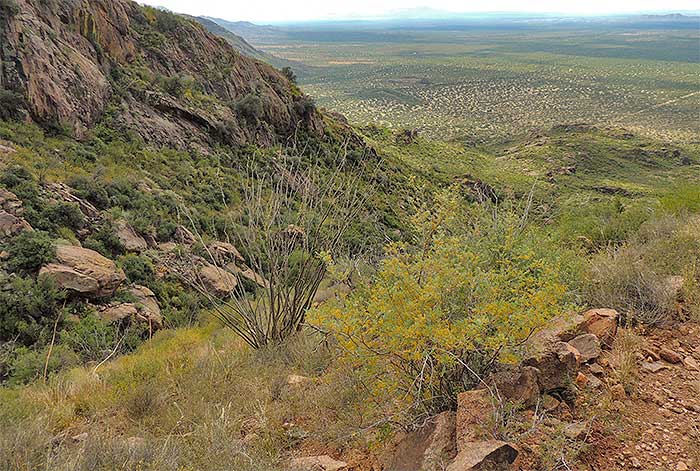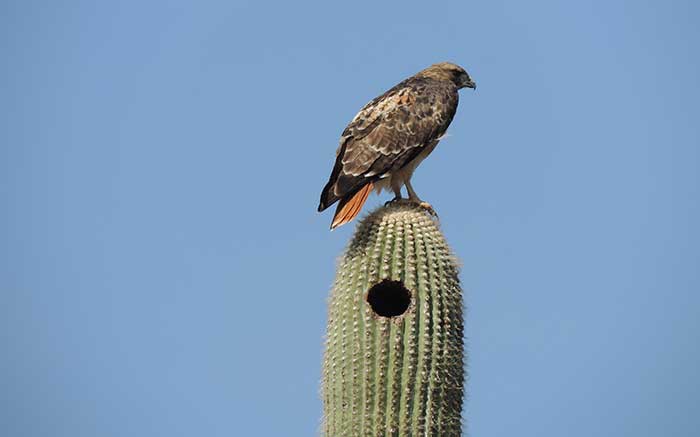Baboquivari Peak Wilderness
Journey into a Sacred Wilderness

Baboquivari Peak. Photo by Soraya Romero.
As I reviewed a map of Arizona, one region swiftly caught my attention. It was a wilderness area, part of which lies within the 2,900,000-acre Tohono O'odham Reservation located outside of Sells, in southern Arizona. In its mountains is a very prominent peak called Baboquivari Peak. Research revealed that the wilderness area is considered a very sacred place to the Tohono O'odham people living nearby. A friend from archaeology field school was excited to join me; together we planned to journey into this fascinating wilderness area.
From Phoenix, we had a three hour drive ahead of us, and we knew we would be setting up camp long after sunset. The drive took us on long roads through the whimsical Sonoran desert landscape, always towards the setting sun. Silhouettes of ancient saguaros stood majestically tall and picturesque. The sight of a “saguaro forest” against the setting sun’s light is truly magical. The saguaro cactus gives such presence to the desert, around them I feel as if I'm truly in the presence of “the ancient ones”. There is no more profound feeling than that of being surrounded by your ancient natural ancestors. Somehow, I can really feel their presence. I thought long about this during the trip.
Later, we found ourselves in pitch darkness on a dirt road; it was our last ten mile stretch before reaching the campsite. The entire dirt road had that sometimes fun, but mostly annoying, washboard effect, which meant driving extra slowly. We had to accept that it would be some time before we reached our destination. We rolled down our windows and suddenly the sound of wildness filled our ears. The night-time chorus of insects was uninhibitedly loud. The night air was pleasantly cool and a thrilling sense of fascination for what we might see overcame us. At that moment we came upon a figure in the middle of the road. It was a great horned owl! I have been experiencing my share of great horned owl encounters, for which I feel especially fortunate. Ever since my first up-close encounter with a great horned owl, I have felt that the owl is my spirit animal. This horned owl flew up to a large shrub right next to the road and remained there. It was very hard to see though. I tried my best to adjust the settings on my camera to take a good photo, but to no avail. The owl eventually flew away.
As we continued our drive to the campsite, I kept sticking my head out the window to see the stars. Oh the stars! They are such a big part of my spirit. It's so important for me to distance myself from city lights from time to time. Finally, we arrived at the campsite and just as we did, a collared peccary ran in front of us, zig-zagged around for a bit, and ran away into the darkness. This place was filled with so much life. Tired, we went to sleep soon after I pitched the tent. Good-night my starry friends!
In the morning, we ate a quick breakfast and explored the area near camp. Water! A large creek flowed near the campsite; curiosity led us to cross it to see what lay on the other side. There we saw another peccary, who quickly ran away from us. Looking around we found that we were at the base of several grandiose mountains clustered together. Some of the mountain slopes were covered in saguaro cactus. After beginning our hike a bit later, we noticed how dynamic and very green the landscape was, thanks to the uncharacteristic rains the area had received recently. Thick grasses, ocotillo, western coral bean trees, chollas and agaves were thriving in great abundance. I was excited to finally be on the trail. Baboquivari Peak at this point was completely hidden from view.

Mountains at beginning of trail. Photo by Soraya R.

Ancient Saguaro. Photo by Soraya R.
Most of the trail was overgrown with thick, wild and mostly undisturbed vegetation. My dog kept trying to catch the grasshoppers that leapt from the thick grasses. Parts of the trail were so overgrown that we had to push our way through using our shins, and on nearly every switchback we marveled at the vast expanse of desert greened from the rains, and at the occasional saguaro that stood out from the surroundings.
We had just turned upward on another switchback when my friend stopped suddenly. We both gasped at the sight of a large desert tortoise poised on the trail before us. I smiled to think how old he might be and how successful he had been. I was impressed by his route which seemed most daring for a tortoise. He was on the trail next to a very steep edge and was unfazed by our presence, never retracting his head, not even when I took a close up photo of him. I was so delighted to see a tortoise; the Sonoran desert tortoise (Gopherus morafkai) is protected and has been listed as threatened by the Endangered Species Act; their primary threat: habitat loss. I was glad to know this guy was safe out there, as the area is still very wild and undeveloped.

Desert Tortoise on Baboquivari Trail. Photo by Soraya R

Grassy Saddle. Photo by Soraya R.
We continued our climb and reached a very grassy saddle which overlooked a large green valley. Continuing upward, we wondered which direction the trail would take us, as the peak was still out of our view. We knew we wouldn’t be able to reach the summit since it required climbing gear but we were determined to reach the peak’s base and go as far as we could. As I made my way through, out from the grasses fluttered two quail. These quail were unusual, they were not Gambel’s nor were they scaled quail. I believe what I saw was a Montezuma quail! Is that even possible? Like the scaled quail back home, it fled too quickly for me to take a photo. I am fairly certain it was not a scaled quail, and I am positive it wasn’t a Gambel’s quail. The Montezuma quail (Cyrtonyx montezumae) is a very, very secretive bird found in Mexico and southern Arizona, a “prized” game bird. They are known to nest in very tall grassy areas, just like this was. And the vegetation was very thick indeed and it grew thicker and thicker as we continued. We went as far as we could make out the trail, but it eventually faded away. At this point we could see the sacred peak, towering straight ahead of us, its prominence clear. We continued a short ways beyond where the trail disappeared to see if we could spot a continuation but the path was nowhere to be found. Clouds began rolling in. I enjoyed the shade on our descent. Somehow, the landscape looked even more green as we returned. Back at camp, we went to the creek to soak our feet and discovered a nice large-sized spring with a small waterfall.

Desert greened by rains - view from Baboquivari trail. Photo by Soraya R.

Saguaro and Spring. Photo by Soraya R.
Later, as we were making dinner, a man with long dark hair, wearing a purple shirt and a yellow and orange bandana approached our site. He was the camp host and introduced himself as James, a native member of the community. He was very friendly and we talked about wildlife and animal encounters. I told him about the owl and how I felt it was my spirit animal. He said animals were considered very important to his people and that the great horned owl is a protector. I told him how I often find feathers on my hikes, which led to my trail name Wild Feather. James told us about his connection to the eagle and how he acquired an eagle feather during an important time in his life. He related that these mountains harbor lots of life, from the common raven to exotic coatis and jaguars. I recalled my remote camera research and remembered citing sources of recorded jaguar sightings in southern Arizona. Though he thought the jaguars were now mostly gone, he believes he heard one once while hiking alone in the area. It was great fun speaking with James, he even shared some secrets about the mountains with us. He kindly made us feel at peace, telling us we could call on him if we needed anything.

Photo by Soraya R. “Sun-painted Mountains”
Later we watched the sunset paint the mountains a brilliant orange-pink. Tired, my friend and I fell asleep as soon as darkness fell. I awoke at around 1:30 am and got up to look at the stars one last time. The Milky Way’s light splashed across the night sky as the nighttime chorus commenced. The next morning, we packed our things, waved good-bye to James and drove the long dirt road away from Baboquivari. On the drive out we saw around fifteen feral horses and a red-tailed hawk atop a very large saguaro. It was a lovely wilderness area I hope to revisit. The native Tohono O’odham consider this a sacred place, but they truly consider all land as sacred; as do I.

Feral Horses
Historically, the O’odham people inhabited areas as far south as Sonora, Mexico and most parts of south and central Arizona. Land settlement, mining and other developments resulted in the rapid loss of O’odham land in both Mexico and Arizona. In 1927 reserves were created for the tribe. Today several O’odham communities are fragmented by the Mexico and United States border. Immigration restrictions prevent members of these communities from freely crossing the border; members of the community remain divided. This restriction has interfered tremendously with their traditions of food gathering and obtaining the natural materials on which their culture relies. The border has also interfered with religious ceremonies that necessitate a temporary migration to other locations within their communities.

Red-tailed Hawk on Saguaro. Photo by Soraya Romero.
Tohono O’odham translates as the People of the Desert; they are one of many tribes that once flourished thoroughout Arizona as self-sustaining peoples. The land was much different not more than 100 years ago. Rivers flowed, there were many trees and life was good. However, when the conquistadors came they dammed the rivers, disrupting the native people's way of life.

Water tank at trailhead with O’odham “Man in the Maze” symbol. Photo by Soraya Romero.
Every time a river is dammed and a territory is claimed, the people and land suffer. We must remember that sacred lands are not limited to only special portions of land revered by tribal nations. All wild places create and support life. All wild places are sacred.
Text and photos by Soraya Romero
More Places to Visit in Arizona
Related DesertUSA Pages
- How to Turn Your Smartphone into a Survival Tool
- 26 Tips for Surviving in the Desert
- Your GPS Navigation Systems
May Get You Killed
- 7 Smartphone Apps to Improve Your Camping Experience
- Desert Survival Skills
- Successful Search & Rescue Missions with Happy Endings
- How to Keep Ice Cold in the Desert
- Desert
Survival Tips for Horse and Rider
- Preparing
an Emergency Survival Kit
Share this page on Facebook:
The Desert Environment
The North American Deserts
Desert Geological Terms



